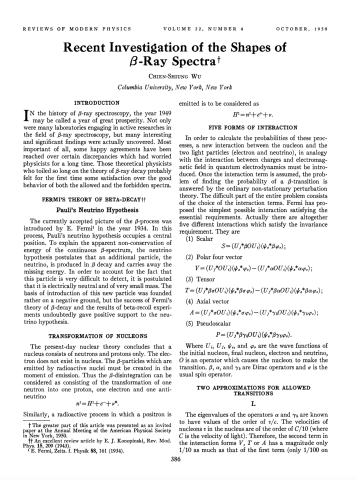Recent Investigation of the Shapes of Beta-Ray Spectra

In the history of β-ray spectroscopy, the year 1949 may be called a year of great prosperity. Not only were many laboratories engaging in active researches in the field of β-ray spectroscopy, but many interesting and significant findings were actually uncovered. Most important of all, some happy agreements have been reached over certain discrepancies which had worried physicists for a long time. Those theoretical physicists who toiled so long on the theory of β-ray decay probably felt for the first time some satisfaction over the good behavior of both the allowed and the forbidden spectra.
The β-radiation from He6 (He6—->Li6+β+v) was one of the historic cases which first suggested the Gamow-Teller selection rules. He6 emits β-rays of a maximum energy of more than 3 Mev with a half-life of less than one sec. Its ft value, of the order of 102 - 103 sec. , indicates that it undergoes a transition of superallowed case. On the other hand, He6 may be considered as consisting of one α῏particle and two neutrons. The α-particle has spin equal to zero and the two neutrons in the ground state should have spin zero. The spin of He6 should therefore be expected to be zero, as is the case for all the known nuclei consisting of even number of neutrons and protons. Li6 may be considered as made up of an α-particle and a deuteron. The spin of the deuteron is i; so Li6 should have Ι=i. The change of spin involved in this transition is therefore ΔI= i. The selection rules of allowed transition as given by the originally proposed interactions (scalar and polar vector form) known as Fermi's selection rules do not permit any change of spin units in the allowed transitions. The experimentally indicated allowed transition of He6 certainly contradicts this class of selection rules. Gamow and Teller, therefore, pointed out that under tensor or axial vector interaction form a change of spin of one unit is permitted even in allowed transitions, owing to the special property of the spin operator ρ used in those two interaction forms (see section under Selection Rules).
Much attention has been given to the case of He6 ever since. But due to its fast decay rate and gaseous form, no accurate information on its upper energy value or its exact spectrum shape was available for a long time. Recently Brown and Perez-Mendez perfected a method of continuously circulating radioactive gas between an activation chamber inside of a cyclotron and a source chamber of a magnetic β-spectrometer. They were able for the first time to determine the upper energy limit of He6 accurately to 3.215+0.015 Mev. Furthermore the β-spectrum yields a straight allowed Fermi plot from the upper end to the low energy region of 150 kev—a span of 95 percent of the whole energy range (Fig. 8).